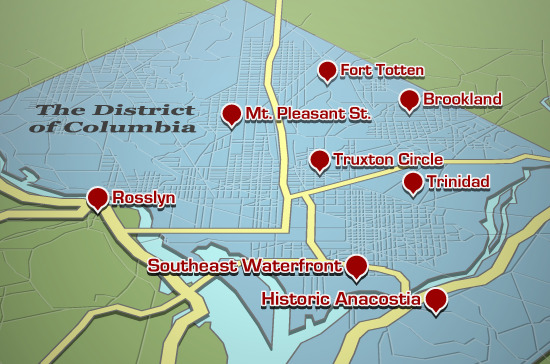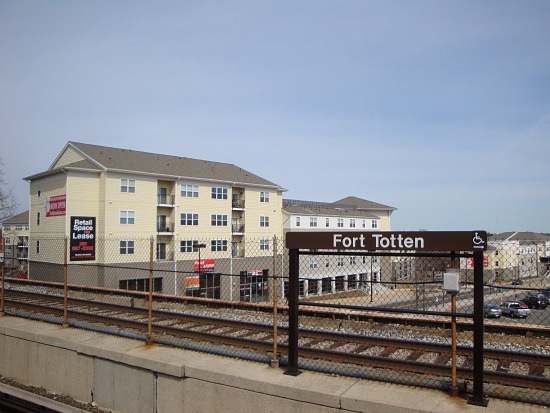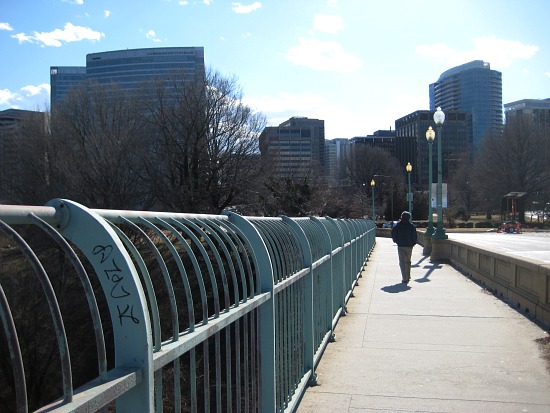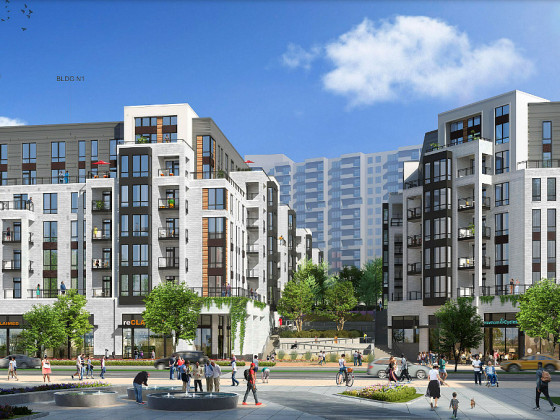 The Neighborhoods of 2015, Revisited
The Neighborhoods of 2015, Revisited
✉️ Want to forward this article? Click here.

In 2010, UrbanTurf reached out to a selection of bloggers, journalists, real estate agents and developers to give us their thoughts on what unsung DC neighborhood would be attracting homebuyers in 2015. Two years later, we decided to check in with the same group to see if they still agree with the choices they made in 2010.
Below you’ll find their thoughts from 2010, followed by their current opinions.

Historic Anacostia
Historic Anacostia
By Nate Guggenheim, real estate agent with Washington Fine Properties
2010:
I think that the most overlooked part of the city and the one that will offer a true opportunity to the investor and the pioneer alike (over the long term) is the historic portion of Anacostia. I am talking about the lettered and numbered streets of the 20020 zip code. Where else, within minutes of downtown, with absolutely gorgeous views of the city is it possible to purchase a three-bedroom house (detached and in good condition) for well below $250,000? What could be the perfect real estate storm exists: proximity to public transport, a decent zoning plan with commercial near enough to residential, public parks and pools, easy access in and out of the city and a generally quaint form of architecture that would appeal to many. It is far riskier than a Petworth or LeDroit, but the upside potential could be huge and a movement towards the other side of the Anacostia River could lead to great things for the city as a whole. Call me crazy…perhaps 2025.
2012:
I will hold my ground that Anacostia and the historic areas, in particular, represent a potential long-term gold mine for real estate investors. Year over year, the numbers have shown statistically relevant gains in average and high sales prices. From January to June 2011, the highest sale for fee-simple homes in the 20020 zip code was $385,000 and the average sales price was $174,089. In the same period this year (1/1/12-6/1/12) the highest sale was $430,000, and the average sales price was $186,690. This is a gain on average of just over 7%, which is much greater that national or local averages.
I don’t know that the area will have the same cachet that U Street and Logan Circle have gleaned in recent years, yet the potential for growth is unquestionably there. 2015? I don’t know. Certainly soon though.

Mount Pleasant Street
Mount Pleasant Street
By Lydia DePillis, author of Housing Complex at the Washington City Paper
2010:
I know, Mount Pleasant is not exactly a marginal area at the moment. But think about the contrast between how the demographics of the neighborhood have changed and how much its central artery has stayed the same: Small Salvadoran restaurants and shops with odds and ends, not much in the way of nightlife beyond the Raven, and a surplus of vacant storefronts. In part because landlords still insist on charging unrealistically high rents, it’s nowhere near the kind of vibrant commercial avenue that the young, increasingly affluent population could support. Various plans have circulated to revitalize the strip, but agreement has been elusive, and none have come to fruition.
I’m going to go ahead and project, however, that within the next five years, demographic pressures will overwhelm the malaise. A streetscape plan will widen sidewalks enough for healthy pedestrian traffic, the success of places like Dos Gringos will attract a few more high-quality restaurants, and the rebuilding of the fire-ravaged Deauville apartments will fill a hole that has haunted the strip for two years. With some work, the small businesses that have stayed for years will survive and prosper as well.
2012:
No, the Deauville apartments have not been miraculously reborn. And no, the neighborhood hasn’t acquired a swath of hip new restaurants to rival Penn Quarter or H Street. But Mt. Pleasant has undoubtedly made progress over the past few years: a dedicated coffeeshop finally arrived and an honest-to-goodness vintage boutique. A local businessman has reinvigorated the local hardware store. A couple of “temporia,” pop-up events for crafts and retail have brought life to vacant retail spaces. Perhaps most importantly, nearly all of the voluntary agreements that restricted late night music have finally been lifted, meaning that the place doesn’t shut down at 10:00 p.m. It’s still the old Mt. Pleasant—just making a little better use of its assets.
Next up: Central 14th Street, between Buchanan and Delafield, is the new lower 14th Street. Once they get rid of the bus barn, who knows what could happen.

Rendering of Monroe Street Market’s Art Walk
Brookland
By Jim Abdo, founder of Abdo Development
2010:
Brookland is a wonderful tight-knit neighborhood, with the same turn-of-the-century historic charm of Cleveland Park but without the price tag. It also boasts its own Metro station (just three stops to Union Station) and the cultural amenity of two major universities: Catholic University and Trinity College. Throw in an emerging 12th Street retail district, which will be further expanding with redevelopment of the CUA South Campus, and you have one of the best-kept secrets in all of Washington.
2012:
I remain extremely bullish on Brookland. So much so that since the 2010 UrbanTurf article, we have broken ground on Monroe Street Market with our partners at Bozzuto. At Monroe Street Market, we are accelerating our phasing and bringing three buildings on line simultaneously. These buildings represent nearly 600,000 square feet of development that will include about 550 residences, retail, an arts walk, café zones and more. By creating this dynamic sense of place directly at the Metro, we believe all of Brookland will benefit and become an even more desirable location for families, young professionals, students and existing residents.

Trinidad
Trinidad and Pleasant Plains
By Dan Silverman aka Prince of Petworth
2010:
I know the question was 2015 but I’m going to say these neighborhoods are going to be popping by 2020. I’m a big fan of Trinidad. I know many people only associate that neighborhood with random police checks, but it has a stellar location and it is going to benefit from all the growth now being seen in NoMa and along H Street. If I were to buy an investment property it’d be in Trinidad.
Also, look for Pleasant Plains to be hopping in 2015/2020. Remember that Georgia Avenue is slated to get a streetcar in the second phase of deployment, and Pleasant Plains will also benefit from the continued development of Columbia Heights to the west and Petworth/Park View to the north.
Good luck to all who may be in the hunt!
2012:
I’m happy to say I stand by my predictions from 2010. I especially like the Trinidad prediction because not only will it benefit from the continued H Street NE development and the coming streetcars but it will also benefit from Union Market to the east.
I also stand by my prediction that Pleasant Plains is a good place to buy that is often overlooked. In fact, I will extend that prediction even more. I’d say all the neighborhoods from Georgia Avenue and Florida Avenue to the south all the way up to Petworth in the north continue to be a good buy. There are still many vacant storefronts on Georgia Avenue, but some new restaurants/businesses are beginning to open up and I’m hearing that good retail space is becoming hard to find. Another attractive element about these neighborhoods is the fact that they are connected by the Green Line to many other big developments including all the downtown development by the old Convention Center and even the developments by the Navy Yard and baseball stadium. And if Georgia Avenue ever gets a streetcar, we can move that line from Petworth north all the way to Silver Spring. But that might be 2025…

Row houses in Truxton Circle
Truxton Circle
By Suzanne Des Marais, real estate agent with Keller Williams
2010:
I live in Bloomingdale and when I started working over here more than nine years ago, it was definitely considered fringy. Now, I often have buyers come to my open houses or call me with specific interest in the neighborhood, but find that they are priced out. A lot of these folks are ending up in the adjacent neighborhoods of either Truxton Circle (south of Florida Avenue, north of New York Avenue), or NE Eckington (directly to the east across North Capitol Street). Given that a few years ago people bought in Bloomingdale because it was affordable, but now people actually seek the area out, I see the expansion to the close-by neighborhoods as having the same effect in a few years.
2012:
Truxton Circle continues to develop, especially in relation to the commercial activity going on in Bloomingdale and NoMa. There are several new multi-unit buildings that have recently been completed and there are still properties that can be improved. When I’m looking at and advising my clients (both residential and developers) about the next hot neighborhoods, I’m looking for possibility, not what is already completely updated or commercially developed.
This time, I would add in the Georgia Avenue and Florida Avenue Corridors. With the opening of the Howard Theater, several restaurants, and the development planned by Howard University up Georgia Avenue, I think we’ll see the Pleasant Plains and Park View neighborhoods (along the eastern side of Columbia Heights) wake up significantly.

Capitol Riverfront Metro
Southeast Waterfront (aka Capitol Riverfront)
By Ross McWilliams, founder of real estate brokerage and marketing firm McWilliams|Ballard
2010:
Last year, the Southeast Waterfront seemed to be the redheaded stepchild of the development world. There was a ton of negative press out there touting vacant apartment buildings and stalled high-profile developments. Fast forward to today and you have almost 2,000 new residents between the apartments and EYA’s Capitol Quarter and two large parks that are either about to start or are already under construction. By 2015, this neighborhood isn’t going to be built-out by any stretch of the imagination, but it’s going to be a lot further along. Don’t forget, this neighborhood is probably three times the size of the area around the Verizon Center, which took 10 years to get built out and become vibrant, so it’s going to take a while before it’s fully realized. If you look at the bones though – proximity to Capitol Hill, access to Metro and major roads, Nationals Park, a potential streetcar line, a waterfront park that I think will be one of the best in the city and of course the river – this neighborhood starts to make a lot of sense as a place to live. If you assume that Half Street is finished in five years and some of Forest City’s The Yards is completed, this neighborhood is going to be really appealing to people.
2012:
On Tuesday night, I strolled down to Nationals Stadium from Capitol Hill where I have lived for 25 years to take in a Nats/Mets game. I passed under the freeway and through the nearly completed EYA Capitol Quarter neighborhood of brightly colored townhomes occupied by professional singles, couples and young families. A block or two later, I came upon the construction of the much anticipated Canal Park which promises restaurant pavilions and winter ice skating. As I walked by the DOT buildings and moved closer to the Anacostia waterfront, I saw the excavation for the new Harris Teeter and then the outdoor areas that serve as farmer markets during the day. I saw that the new Foundry Lofts apartments are now occupied, many with balconies and pretty incredible water views. I then came upon the new waterfront park that is unlike any I’ve seen in DC: illuminated benches, beautiful landscaping, water features and waterfalls, walking paths and sculpture everywhere.
My walking tour of the Southeast Waterfront neighborhood was as enjoyable as the baseball game (Nats won 7-6 in the 12th inning). At the game, I met Linda and Steve Mitchell who raved about their new coop at Capitol Hill Tower. They love their neighborhood and see change occurring every week.
As I walked home — down the new boardwalk along the river that recently opened connecting the Nationals Stadium to the residential and commercial buildings and soon the new restaurants that will front the river and waterfront park — I thought to myself that all the wait really was worth it. The vision for this new vibrant neighborhood is almost there…and probably before 2015.

Fort Totten Metro
Fort Totten
By Kevin Wood, real estate agent with William Sawyer & Co.
2010:
Fort Totten is a post-war neighborhood in Northeast that should see a lot of activity over the next few years as several large-scale developments around the Fort Totten Metro get under way, including a massive 1,000-unit development that will include a new grocery store. Fort Totten is missing a core like 14th and Irving in Columbia Heights as the area now is just street after street of brick rowhouses. That will likely change with the coming development, and given the fact that there is a Metro stop on the Red Line, and that it’s close in, Fort Totten should witness a renaissance and see an influx of new residents eager to take advantage of the lower-priced housing.
2012:
I still think Fort Totten is a neighborhood to watch. That whole part of NE — including Brookland, Woodridge, Michigan Park, Fort Lincoln — is seeing a lot of new developments come out of the ground that are going to transform the area. The new Costco/Lowes project at Fort Lincoln, the Cafriz project at Fort Totten, as well as the huge new mixed-use development at the Brookland Metro are going to alter the way many new buyers view the area and its livability.

View into Rosslyn from the Key Bridge
Rosslyn
By Ken Johnson, publisher of DCmud
I chose Rosslyn, not for the typical reasons of blight-to-gentrification, but because it was always known as being not DC – a tall, orderly, bland, homogenized, 9-to-5 refuge to DC’s busy, demographically complicated, oxidized urbanity. With a flight of new residential buildings and more on the way (pricey as they may be), Rosslyn is on the verge of developing a neighborhood. Imagine, if you will, sit-down restaurants, markets open on weekends, coffee houses, people coming to the neighborhood for dinner and a movie. If the business district can tackle middle age, and remedy its overly wide streets, walkways to nowhere, retail problem, and unbuffered sidewalks — all of which the local BID has pondered — it may yet offer more than just office space in a safe zip code. And did I mention that it’s close to DC?
Ken Johnson was unable to get back to us with his updated opinion prior to publication of this article.
See other articles related to: brookland, capitol riverfront, editors choice, fort totten, historic anacostia, mount pleasant, neighborhoods, neighborhoods of 2015, pleasant plains, rosslyn, trinidad, truxton circle
This article originally published at https://dc.urbanturf.com/articles/blog/the_neighborhoods_of_2015_revisited/5631.
Most Popular... This Week • Last 30 Days • Ever

With frigid weather hitting the region, these tips are important for homeowners to ke... read »

Today, UrbanTurf offers a brief explanation of what it means to lock in an interest r... read »

A new report from DC’s Office of Revenue Analysis highlights how millennials and wo... read »

The 30,000 square-foot home along the Potomac River sold at auction on Thursday night... read »

An application extending approval of Friendship Center, a 310-unit development along ... read »
DC Real Estate Guides
Short guides to navigating the DC-area real estate market
We've collected all our helpful guides for buying, selling and renting in and around Washington, DC in one place. Start browsing below!
First-Timer Primers
Intro guides for first-time home buyers
Unique Spaces
Awesome and unusual real estate from across the DC Metro














